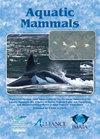怀孕和哺乳期阿拉斯加海豹(Phoca vitulina)脂肪脂肪酸的检测
IF 0.8
4区 生物学
Q4 MARINE & FRESHWATER BIOLOGY
引用次数: 0
摘要
怀孕和哺乳对雌性哺乳动物的能量消耗非常大,并极大地影响了物种特异性生殖策略的进化。海狮(“真”海豹)的哺乳时间通常很短,并且严重依赖于储存的能量,而耳狮(海狮和海豹)的哺乳时间通常要长得多,并且通过觅食来补充能量。而作为一个phocid,较小的体型的斑海豹(Phoca vitulina)被认为排除了维持哺乳仅从储存的能量。因此,它们的哺乳策略被认为是介于耳类动物和耳类动物之间的。本研究的目的是表征怀孕和哺乳期海豹的鲸脂脂肪酸(FAs),并确定哺乳期海豹的鲸脂脂肪酸谱是否更接近于鲸脂或耳脂。女性生殖状态(哺乳期,n = 18;怀孕,n = 7;未哺乳-未怀孕,n = 17),母子对(n = 6)和家庭(n = 3;使用排列方差分析(peromova)评估phocid, n = 3)。与哺乳期雌海豹相比,怀孕的海豹脂肪中多不饱和脂肪酸(PUFAs)含量升高,单不饱和脂肪酸(MUFAs)含量降低,这表明怀孕的海豹可能优先考虑脂肪中多不饱和脂肪酸的储存。此外,与怀孕的斑海豹相比,哺乳期斑海豹的PUFA含量较低,饱和脂肪酸(sfa)和MUFA≤16C,这表明哺乳期斑海豹可能像利用其他脂肪酸一样利用脂肪脂肪酸。最后,尽管鲸脂SFA和MUFA浓度在鳍足类动物家族中可能是保守的,但在哺乳期的磷脂类动物和耳蜗类动物中PUFA浓度似乎是相似的,这表明哺乳期物种可能以类似的方式选择性地从鲸脂中动员PUFA,尽管有家族或哺乳策略。了解家族和体型大小如何影响一个物种的哺乳策略,可以让我们更深入地了解一个物种在其生命历史的关键时期可能受到的内部和外部力量的生理和行为限制。本文章由计算机程序翻译,如有差异,请以英文原文为准。
Examination of Blubber Fatty Acids in Pregnant and Lactating Alaskan Harbor Seals (Phoca vitulina)
Pregnancy and lactation are energetically expensive for female mammals and greatly influence the evolution of species-specific reproductive strategies. Phocid (“true” seals) lactation is generally short in duration and relies heavily on stored energy, whereas otariid (sea lions and fur seals) lactation is generally much longer, and energy is supplemented by foraging. While a phocid, the smaller body size of the harbor seal (Phoca vitulina) is assumed to preclude the maintenance of lactation solely from stored energy. For this reason, their lactation strategy is believed intermediate to that of otariids and phocids. The purpose of this study was to characterize blubber fatty acids (FAs) of pregnant and lactating harbor seals and determine if lactating blubber FA profiles more closely resemble phocids or otariids. Blubber FA differences between female reproductive states (lactating, n = 18; pregnant, n = 7; non-lactating–non-pregnant, n = 17), mother–pup pairs (n = 6), and families (otariid, n = 3; phocid, n = 3) were evaluated using permutation analysis of variance (PERMANOVA). Compared to lactating females, pregnant harbor seals had elevated polyunsaturated FAs (PUFAs) and decreased monounsaturated FAs (MUFAs) in their blubber, suggesting pregnant harbor seals may prioritize PUFA storage in the blubber. Additionally, when compared to their pregnant counterparts, lactating harbor seals had lower PUFA, as well as saturated FAs (SFAs) and MUFA ≤ 16C, suggesting lactating harbor seals may utilize blubber FAs similar to other phocids. Lastly, while blubber SFA and MUFA concentrations may be conserved among pinniped families, PUFA concentrations among lactating phocids and otariids appear to be similar, suggesting lactating species may selectively mobilize PUFA from the blubber in a similar way despite family or lactation strategy. Understanding how family and body size influence the lactation strategy of a species provides greater insight into the physiological and behavioral limitations a species may have to both internal and external forces during such a critical time in its life history.
求助全文
通过发布文献求助,成功后即可免费获取论文全文。
去求助
来源期刊

Aquatic Mammals
MARINE & FRESHWATER BIOLOGY-ZOOLOGY
CiteScore
1.60
自引率
16.70%
发文量
99
审稿时长
>12 weeks
期刊介绍:
Aquatic Mammals is a peer-reviewed journal sponsored by the European Association for Aquatic Mammals (EAAM), the Alliance of Marine Mammal Parks and Aquariums (AMMPA), and the International Marine Animal Trainers’ Association (IMATA). Aquatic Mammals publishes articles related to marine mammals (whales, dolphins, seals, fur seals, sea lions, walrus, dugongs, manatees, sea otters, and polar bears). Topics of publication on both captive animals and wild marine mammals include aspects of husbandry; behavior; conservation; veterinary medicine; anatomy; physiology; training; population trends; and the effects of pollution, climate change, and noise.
 求助内容:
求助内容: 应助结果提醒方式:
应助结果提醒方式:


